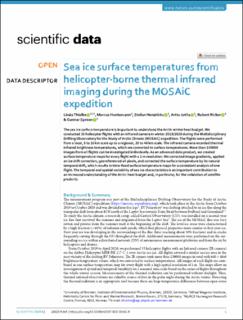| dc.contributor.author | Thielke, Linda | |
| dc.contributor.author | Huntemann, Marcus | |
| dc.contributor.author | Hendricks, Stefan | |
| dc.contributor.author | Jutila, Arttu | |
| dc.contributor.author | Ricker, Robert | |
| dc.contributor.author | Spreen, Gunnar | |
| dc.date.accessioned | 2023-09-15T08:48:02Z | |
| dc.date.available | 2023-09-15T08:48:02Z | |
| dc.date.created | 2022-08-10T12:11:40Z | |
| dc.date.issued | 2022 | |
| dc.identifier.citation | Scientific Data. 2022, . | en_US |
| dc.identifier.issn | 2052-4463 | |
| dc.identifier.uri | https://hdl.handle.net/11250/3089664 | |
| dc.description.abstract | The sea ice surface temperature is important to understand the Arctic winter heat budget. We conducted 35 helicopter flights with an infrared camera in winter 2019/2020 during the Multidisciplinary Drifting Observatory for the Study of Arctic Climate (MOSAiC) expedition. The flights were performed from a local, 5 to 10 km scale up to a regional, 20 to 40 km scale. The infrared camera recorded thermal infrared brightness temperatures, which we converted to surface temperatures. More than 150000 images from all flights can be investigated individually. As an advanced data product, we created surface temperature maps for every flight with a 1 m resolution. We corrected image gradients, applied an ice drift correction, georeferenced all pixels, and corrected the surface temperature by its natural temporal drift, which results in time-fixed surface temperature maps for a consistent analysis of one flight. The temporal and spatial variability of sea ice characteristics is an important contribution to an increased understanding of the Arctic heat budget and, in particular, for the validation of satellite products. | en_US |
| dc.language.iso | eng | en_US |
| dc.relation.uri | https://www.nature.com/articles/s41597-022-01461-9.pdf | |
| dc.rights | Navngivelse 4.0 Internasjonal | * |
| dc.rights.uri | http://creativecommons.org/licenses/by/4.0/deed.no | * |
| dc.subject | Sea ice | en_US |
| dc.title | Sea ice surface temperatures from helicopter-borne thermal infrared imaging during the MOSAiC expedition | en_US |
| dc.title.alternative | Sea ice surface temperatures from helicopter-borne thermal infrared imaging during the MOSAiC expedition | en_US |
| dc.type | Peer reviewed | en_US |
| dc.type | Journal article | en_US |
| dc.rights.holder | © The Author(s) 2022 | en_US |
| dc.description.version | publishedVersion | en_US |
| cristin.ispublished | true | |
| cristin.fulltext | original | |
| cristin.qualitycode | 1 | |
| dc.identifier.doi | 10.1038/s41597-022-01461-9 | |
| dc.identifier.cristin | 2042160 | |
| dc.source.journal | Scientific Data | en_US |
| dc.source.pagenumber | 16 | en_US |
| dc.relation.project | Andre: MOSAiC20192020 | en_US |
| dc.relation.project | Andre: IceSense 03F0866B | en_US |
| dc.relation.project | Andre: IceSense 03F0866A | en_US |
| dc.relation.project | Deutsche Forschungsgemeinschaft: 221211316 | en_US |
| dc.relation.project | Deutsche Forschungsgemeinschaft: 420499875 | en_US |
| dc.subject.nsi | VDP::Miljøteknologi: 610 | en_US |
| dc.subject.nsi | VDP::Environmental engineering: 610 | en_US |

